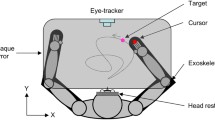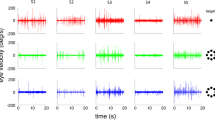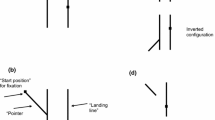Abstract
We have assessed the contribution made by retinal and extraretinal signals when subjects used their hand to track targets moving at constant velocities. Comparisons were made between responses produced under the following conditions: (1) with full vision of the hand and unrestricted movement of the eyes, (2) without vision of the hand or (3) while visually fixating a stationary LED. Target velocity was varied in a pseudo-random order across trials. In each condition response latency decreased as target velocity was increased. There was a ∼24 ms increase in latency when vision of the hand was removed or eye movements were restricted. Under normal conditions, subjects were able to accurately catch up to and match target velocity with their hand. When vision of the hand was removed, subjects lagged behind the target but were able to match target velocity. This deficit was eliminated when vision of the hand was made available for the beginning of the response. When subjects were required to visually fixate they could catch up to the target with their hand, but subsequently produced a steady state hand velocity that was greater than target velocity. When the LED was positioned such that the target started in the peripheral visual field, the overestimation of target velocity was evident from the beginning of the response: subjects produced initial accelerations with their hand that were significantly greater than in normal conditions. Finally, normal responses were produced when subjects were required to visually pursue a second target that moved at the same speed and in the same direction as the main target. When the velocities of these two targets differed, subjects produced hand movements that were initially more appropriate for the target being visually pursued. Together these results suggest that vision of the hand and how it is initially positioned relative to the target is necessary to catch up to the target; whereas the extraretinal signal concerned with eye velocity is required to produce an accurate steady state hand velocity.
Similar content being viewed by others
References
Beppu H, Nagaoka M, Tanaka R (1984) Analysis of cerebellar motor disorders by visually guided elbow tracking movements. Brain 107:787–809
Bock O (1986) Contribution of retinal versus extraretinal signals towards visual localization in goal-directed movements. Exp Brain Res 64:476–482
Carl JR, Gellman RS (1987) Human smooth pursuit: stimulus-dependent responses. J Neurophysiol 57:1446–1463
Carnahan H, Marteniuk RG (1991) The temporal organization of hand, eye, and head movements during reaching and pointing. J Motor Behav 23:109–119
Collewijn H (1972) Latency and gain of the rabbit's optokinetic reactions to small movements. Brain Res 36:59–70
Delreux V, Vanden Abeele S, Crommelinck M, Roucoux A (1991) Interaction between goal-directed eye and arm movements: arguments for an interdependent motor control. J Motor Behav 23:147–151
Dichgans J, Wist E, Diener HC, Brandt T (1975) The Aubert-Fleischl phenomenon: a temporal frequency effect on perceived velocity in afferent motion perception. Exp Brain Res 23:529–533
Donkelaar P van, Lee RG, Gellman RS (1992a) The contribution of visual and eye motion signals in directing the arm to moving targets. Soc Neurosci Abstr 18:1551
Donkelaar P van, Lee RG, Gellman RS (1992b) Control strategies in directing the hand to moving targets. Exp Brain Res 91:151–161
Festinger L, Canon LK (1965) Information about spatial location based on knowledge about efference. Psychol Rev 72:373–384
Frens MA, Erkelens CJ (1991) Coordination of hand movements and saccades: evidence for a common and a separate pathway. Exp Brain Res 85:682–690
Gauthier GM, Vercher J-L, Mussa Ivaldi F, Marchetti E (1988) Oculo-manual tracking of visual targets: control learning, coordination control and coordination model. Exp Brain Res 73:127–137
Gellman RS, Carl JR (1991) Motion processing for saccadic eye movements in humans. Exp Brain Res 84:660–667
Honda H (1990) The extraretinal signal from the pursuit-eyemo vement system: its role in the perceptual and the egocentric localization systems. Percept Psychophys 48:509–515
Koken PW, Erkelens CJ (1992) Influences of hand movements on eye movements in tracking tasks in man. Exp Brain Res 88:657–664
Lisberger SG, Morris EJ, Tychsen L (1987) Visual motion processing and sensory-motor integration for smooth pursuit eye movements. Ann Rev Neurosci 10:97–129
Movshon JA, Lisberger SG, Krauzlis RJ (1990) Visual cortical signals supporting smooth pursuit eye movements. Cold Spring Harbor Symp Quant Biol 55:707–716
Prablanc C, Echallier JF, Komilis E, Jeannerod M (1979a) Optimal response of eye and hand motor systems in pointing at a visual target. I. Spatio-temporal characteristics of eye and hand movements and their relationships when varying the amount of visual information. Biol Cybern 35:113–124
Prablanc C, Echallier JF, Komilis E, Jeannerod M (1979b) Optimal response of eye and hand motor systems in pointing at a visual target. II. Static and dynamic visual cues in the control of hand movement Biol Cybern 35:183–187
Prablanc C, Pelisson D, Goodale MA (1986) Visual control of reaching movements without vision of the limb I. Role of retinal feedback of target position in guiding the hand. Exp Brain Res 62:293–302
Robinson DA (1981) Control of eye movements. In: Brooks VB (eds) Handbook of physiology, The nervous system, vol II, part 2. Williams & Wilkins, Baltimore, pp 1275–1320
Tynan PD, Sekuler R (1982) Motion processing in peripheral vision: reaction time and perceived velocity. Vision Res 22:61–68
Author information
Authors and Affiliations
Rights and permissions
About this article
Cite this article
van Donkelaar, P., Lee, R.G. & Gellman, R.S. The contribution of retinal and extraretinal signals to manual tracking movements. Exp Brain Res 99, 155–163 (1994). https://doi.org/10.1007/BF00241420
Received:
Accepted:
Issue Date:
DOI: https://doi.org/10.1007/BF00241420




